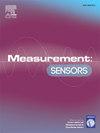Force signals time alignment using cross-correlation
Q4 Engineering
引用次数: 0
Abstract
Calibration of force in measuring systems where the force is time dependent i.e. dynamically changing, introduces additional complexities versus quasi-static calibration conditions. The basic need in the case of time variable force signals is to synchronise the measurement series from unit under test and the measurement series from the reference standard. As they are typically acquired by different measuring systems, post-processing is generally necessary to align the measured samples to try to eliminate the influence of the sample misalignment from the resulting testing machine indication error. The paper focuses on the time alignment of measurement series at testing machine calibration with cyclic force excitation using cross-correlation to determine the necessary time correction. The standard deviation of the error distribution for the two measured signals after time correction was below 0.2 % for 5 kN ± 1 kN cycling force for 1 Hz, 5 Hz, and 10 Hz cycling frequency.
力信号时间对齐使用互相关
在力随时间变化(即动态变化)的测量系统中,力的校准与准静态校准条件相比引入了额外的复杂性。在时变力信号的情况下,基本需要是同步来自被测单位的测量序列和来自参考标准的测量序列。由于它们通常是由不同的测量系统获得的,因此通常需要后处理来校准测量样品,以试图消除样品不校准对结果试验机指示误差的影响。本文主要研究了在循环力激励下试验机标定时测量序列的时间对中,利用互相关确定必要的时间校正。在1hz、5hz和10hz的循环频率下,当循环力为5kn±1kn时,两个测量信号经过时间校正后的误差分布标准差均小于0.2%。
本文章由计算机程序翻译,如有差异,请以英文原文为准。
求助全文
约1分钟内获得全文
求助全文
来源期刊

Measurement Sensors
Engineering-Industrial and Manufacturing Engineering
CiteScore
3.10
自引率
0.00%
发文量
184
审稿时长
56 days
 求助内容:
求助内容: 应助结果提醒方式:
应助结果提醒方式:


